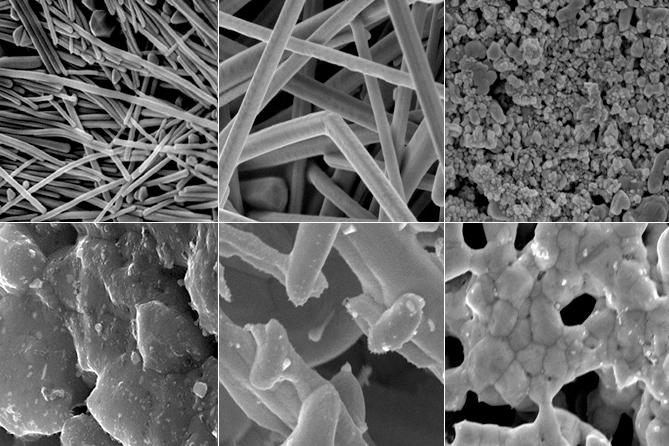Nanowire ‘inks’ enable low-cost paper- or plastic-based printable electronics
January 6, 2017

Duke University chemists have found that silver nanowire films like these conduct electricity well enough to form functioning circuits without applying high temperatures, enabling printable electronics on materials like paper or plastic. (credit: Ian Stewart and Benjamin Wiley)
By suspending tiny metal nanoparticles in liquids, Duke University scientists can use conductive ink-jet-printed conductive “inks” to print inexpensive, customizable RFID and other electronic circuit patterns on just about any surface — even on paper and plastics.
Printed electronics, which are already being used widely in devices such as the anti-theft radio frequency identification (RFID) tags you might find on the back of new DVDs, currently have one major drawback: for the circuits to work, they first have to be heated to 200° C (392°F) to melt all the nanoparticles together into a single conductive wire.
But Duke researchers have now found that electrons are conducted through films made of silver nanowires much more easily than with films made from other shapes (like nanospheres or microflakes). And the nanowire films can now function in printed circuits without the need to melt them first — heating at only 70° C (158°F) is required — and that means the circuits can be printed on cheaper plastics or paper.
“The nanowires [in their research] had a 4,000 times higher conductivity than the more commonly used silver nanoparticles that you would find in printed antennas for RFID tags,” said Benjamin Wiley, assistant professor of chemistry at Duke.
The technology could also be used to make lower-cost solar cells, printed displays, LEDs, touchscreens, amplifiers, batteries, and even some implantable bio-electronic devices. The results appeared online Dec. 16 in ACS Applied Materials and Interfaces.
The team is now experimenting with using aerosol jets to print silver nanowire inks in usable circuits. Wiley says they also want to explore whether silver-coated copper nanowires, which are significantly cheaper to produce than pure silver nanowires, will give the same effect.
This research was supported by funding from the National Science Foundation and a GAANN Fellowship through the Duke Chemistry Department.
Abstract of Effect of Morphology on the Electrical Resistivity of Silver Nanostructure Films
The relatively high temperatures (>200 °C) required to sinter silver nanoparticle inks have limited the development of printed electronic devices on low-cost, heat-sensitive paper and plastic substrates. This article explores the change in morphology and resistivity that occurs upon heating thick films of silver nanowires (of two different lengths; Ag NWs), nanoparticles (Ag NPs), and microflakes (Ag MFs) at temperatures between 70 and 400 °C. After heating at 70 °C, films of long Ag NWs exhibited a resistivity of 1.8 × 10–5 Ω cm, 4000 times more conductive than films made from Ag NPs. This result indicates the resistivity of thick films of silver nanostructures is dominated by the contact resistance between particles before sintering. After sintering at 300 °C, the resistivity of short Ag NWs, long Ag NWs, and Ag NPs converge to a value of (2–3) × 10–5 Ω cm, while films of Ag MFs remain ∼10× less conductive (4.06 × 10–4 Ω cm). Thus, films of long Ag NW films heated at 70 °C are more conductive than Ag NP films sintered at 300 °C. Adding 10 wt % nanowires to a film of nanoparticles results in a 400-fold improvement in resistivity.
